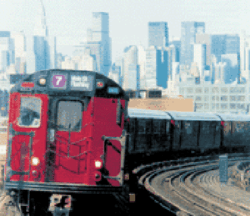7 (New York City Subway service)
  Flushing Local Flushing Express | |||||||||||||||||||||||||||||||||||||||||||||||||||||||||||||||||||||||||||||||||||||||
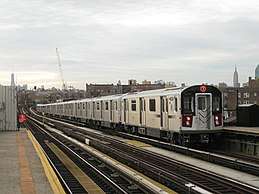 | |||||||||||||||||||||||||||||||||||||||||||||||||||||||||||||||||||||||||||||||||||||||
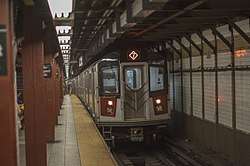 | |||||||||||||||||||||||||||||||||||||||||||||||||||||||||||||||||||||||||||||||||||||||
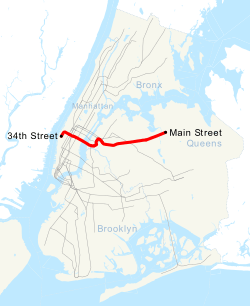 | |||||||||||||||||||||||||||||||||||||||||||||||||||||||||||||||||||||||||||||||||||||||
| Northern end | Flushing–Main Street | ||||||||||||||||||||||||||||||||||||||||||||||||||||||||||||||||||||||||||||||||||||||
|---|---|---|---|---|---|---|---|---|---|---|---|---|---|---|---|---|---|---|---|---|---|---|---|---|---|---|---|---|---|---|---|---|---|---|---|---|---|---|---|---|---|---|---|---|---|---|---|---|---|---|---|---|---|---|---|---|---|---|---|---|---|---|---|---|---|---|---|---|---|---|---|---|---|---|---|---|---|---|---|---|---|---|---|---|---|---|---|
| Southern end | 34th Street–Hudson Yards | ||||||||||||||||||||||||||||||||||||||||||||||||||||||||||||||||||||||||||||||||||||||
| Stations |
22 (local service) 12 (express service) 8 (super express service) | ||||||||||||||||||||||||||||||||||||||||||||||||||||||||||||||||||||||||||||||||||||||
| Rolling stock | 374 to 396 R188s (34 to 36 trains)[1] | ||||||||||||||||||||||||||||||||||||||||||||||||||||||||||||||||||||||||||||||||||||||
| Depot | Corona Yard | ||||||||||||||||||||||||||||||||||||||||||||||||||||||||||||||||||||||||||||||||||||||
| Started service | 1915 | ||||||||||||||||||||||||||||||||||||||||||||||||||||||||||||||||||||||||||||||||||||||
| |||||||||||||||||||||||||||||||||||||||||||||||||||||||||||||||||||||||||||||||||||||||
The 7 Flushing Local and <7> Flushing Express[2] are two rapid transit services in the A Division of the New York City Subway, providing local and express services along the full length of the IRT Flushing Line. Their route emblems, or "bullets", are colored purple, since they serve the Flushing Line.[3]
Local service is denoted by a (7) in a circular bullet, and express service is denoted by a <7> in a diamond-shaped bullet. Several cars also feature LED signs around the service logo to indicate local or express service to riders; a green circle denotes 7 local trains and a red diamond denotes <7> express trains.
7 trains operate at all times between Main Street in Flushing, Queens and 34th Street–Hudson Yards in Chelsea, Manhattan. Local service operates at all times, while express service runs only during rush hours and early evenings in the peak direction and during special events.
The 7 route started running in 1915 when the Flushing Line opened. Since 1927, the 7 has held largely the same route, except for a one-stop western extension from Times Square to Hudson Yards in 2015.
Service history
On June 13, 1915, the first test train on the IRT Flushing Line ran between Grand Central and Vernon Boulevard–Jackson Avenue, followed by the start of revenue service on June 22. Over the next thirteen years, the line was extended piece by piece between Times Square and Flushing–Main Street, after the former opened on March 14, 1927. Shovels used to dig the subterranean portion of the end of the line from Corona to Flushing Main Street were provided by the Marion Power Shovel Company.[4]
Express service started in 1917. The service on the Flushing Line east of Queensboro Plaza was shared by the Interborough Rapid Transit Company and the Brooklyn–Manhattan Transit Corporation from 1912 to 1949; BMT trains were designated 9, while IRT services were designated 7 on maps only. The 7 designation was assigned to trains since the introduction of the front rollsigns on the R12 in 1948.
On November 12, 1947, four additional trains were placed in service on the 7 to accommodate passengers using new parking facilities adjacent to the Willetts Point Boulevard station. On July 14, 1948, 31 additional cars were placed into service on the 7, increasing the number of cars per train from eight to nine.[5]
On March 12, 1953, two nine-car super express trains began operating from Flushing–Main Street to Times Square in the AM rush hour. The super expresses stopped at Main Street, and Willets Point before skipping all stops to Queensboro Plaza, bypassing the Woodside and Junction Boulevard express stops. The running time was cut down to 23 minutes from 25 minutes.[6] Beginning August 12, 1955, four super expresses operated during the AM rush hour.[7]
Holiday and Saturday express service was discontinued on March 20, 1954.[8] At some point afterwards, weekday midday express service was discontinued, but was restored on November 29, 1971, before being discontinued again by August 29, 1975.
On November 1, 1962, fifty R17s (#6500-6549) were transferred from the Mainline IRT to the 7, allowing for ten-car operation. This was the first time that the IRT ran ten-car trains without a second conductor.[9]
From May 13, 1985, to August 21, 1989, the IRT Flushing Line was overhauled for improvements, including the installation of new track, repair of station structures and to improve line infrastructure. The major element was the replacement of rails on the Queens Boulevard viaduct. This was necessitated because the subway was allowed to deteriorate during the 1970s and 80s to the point that there were widespread "Code Red" defects on the Flushing Line, and there were some pillars holding elevated structures that were so shaky that trains wouldn't run if the wind exceeded 65 mph. <7> express service was suspended for the duration of the project; however, extra 7 service was provided for Mets games and Flushing Meadows Park events. The project was completed six months early, and <7> express service was restored on August 21, 1989.[10]:17 However, express trains bypassed 61st Street–Woodside because the Transit Authority was concerned about passengers transferring between local and express trains at that station. The stop was added a few months later after pressure from community opposition.[11]
In the mid-1990s, the MTA discovered that the Queens Boulevard viaduct structure was unstable, as rocks that were used to support the tracks as ballast became loose due to poor drainage, which, in turn, affected the integrity of the concrete structure overall. <7> express service was suspended again between 61st Street–Woodside and Queensboro Plaza; temporary platforms were installed to access the express track in the four intermediate stations.[12] The work began on April 5, 1993.[13] When the viaduct reconstruction finished on March 31, 1997, full <7> express service was reinstated. Throughout this entire period, ridership grew steadily.[14] In 1999, <7> express service was expanded from rush hours only to weekdays from 6:30 a.m. to 10:00 p.m. However, this expansion was cut back in 2009 due to frequent midday construction.
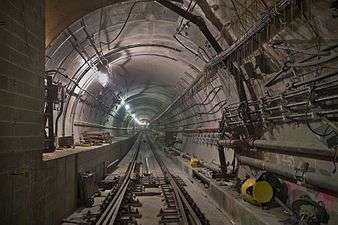
Work has been underway since 2008 to convert the 7 service to accommodate CBTC. Expected to cost $585.9 million, CBTC will allow two additional trains per hour as well as two additional trains for the 7 Subway Extension, providing a 7% increase in capacity.[15] (At the former southern terminal, Times Square, service on the 7 was limited to 27 trains per hour (tph) as a result of the bumper blocks there. The current southern terminal at 34th Street–Hudson Yards has tail tracks to store rush-hour trains and can increase the service frequency to 29 tph.[15]) New cars on order for the A Division (the R188 contract) are compatible with CBTC. Installation of CBTC and delivery of the trains were completed in 2016.[15]
The 7 Subway Extension, which travels west and south to 34th Street and 11th Avenue, near the Jacob K. Javits Convention Center in Hudson Yards, was delayed five times.[16] The 34th Street–Hudson Yards station, originally scheduled to open in December 2013, began serving passengers on September 13, 2015.[17] However, the overall station construction project would not be completed until sometime in 2016.[18][19]
On November 16, 2010, New York City officials announced they are considering a further extension of the service across the Hudson River to the Secaucus Junction train station in New Jersey.[20] As of October 26, 2011, tentative support for the extension has been given by New York City Mayor Michael Bloomberg as well as New Jersey Governor Chris Christie in comments to the press.[21][22] However, in April 2013, then MTA chairman Joseph Lhota announced that the 7 train would not be extended to New Jersey due to the high costs of the project, which included constructing a subway yard and a subway tunnel in New Jersey. Instead, Lhota put his support behind Amtrak’s Gateway Tunnel project which entails a new tunnel to Manhattan for Amtrak and NJ Transit trains.[23] However, as part of a joint effort between The Port Authority of New York and New Jersey, the MTA and NJ Transit, this extension was considered again in February 2018.[24][25][26][27][28]
Rolling stock
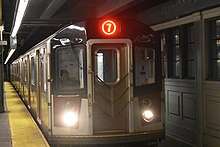
The 7 operates with 11-car sets; the number of cars in a single 7 train set is more than in any other New York City Subway service. These trains, however, are not the longest in the system, since a train of 11 "A" Division cars is only 565 feet (172 m) long, while a standard B Division train, which consists of ten 60-foot cars or eight 75-foot cars, is 600 feet (180 m) long.
Fleet history
The 7, throughout almost all its history, has maintained a separate fleet from the rest of the IRT, starting with the Steinway Low-Vs. The Steinways were built between 1915 and 1925 specifically for use in the Steinway Tunnel. They had special gear ratios to climb the steep grades (4.5%) in the Steinway Tunnel, something standard Interborough equipment could not do.[29]
In 1938, an order of all-new World's Fair cars was placed with the St. Louis Car Company. These cars broke from IRT "tradition" in that they did not have vestibules at each car end. In addition, because the IRT was bankrupt at the time, the cars were built as single ended cars, with train controls for the motorman on one side and door controls for the conductor on the other. These cars spent their last days on the elevated IRT Third Avenue Line in the Bronx.
In 1964, the picture window R33/36 World's Fair (WF) cars replaced the older R12s, R14s, R15s, and some R17s in time for the 1964 New York World's Fair.
Early in 1965, the New York City Transit Authority placed a strip map indicating all the stations and transfer points for the line in each of the line's 430 cars, helping World's Fair visitors. This innovation was not used for other services and as they shared rolling stock with each other, it was possible for cars to have the wrong strip maps.[30]
The 7 was the last service to run using "Redbird" cars, and the 7's fleet consisted entirely of R33/36 WF Redbird train cars until December 2001. In 2001, with the arrival of the R142/R142A cars, the Transit Authority announced the retirement of all Redbird cars. From January 2002 to November 2003, the Bombardier-built R62A cars, which used to operate on the 3 and 6, gradually replaced all of the R33/36 WF cars on the 7. On November 3, 2003, the last Redbird train made its final trip on this route, making all stops between Times Square and the then-named Willets Point–Shea Stadium.[31] Several Redbird cars running on this service were decorated with Mets logos and colors during the 2000 Subway Series against the New York Yankees, as the Flushing Line runs adjacent to Citi Field and the former location of Shea Stadium. Many R33 WFs remained in Corona Yard and were used primarily for work service up to early 2017.
Since 2008, all R62As on the 7 have been upgraded with LED lighted signs to distinguish between express and local trains. These signs are located on the rollsigns that are found on the side of each car. The local is a green circle around the 7 bullet while the express is a red diamond.[32] Previously, the rollsigns showed either a (7) (within a circle) or a <7> (within a diamond) with the word "Express" underneath it.
The R62As were displaced by the R188s from January 2014 to March 2018 in preparation for the automation equipment for the Flushing Line. The displaced R62As were returned to the 6 train, which had given much of its R142As for conversion to R188s.[33][34] The first train of R188 cars began operating in passenger service on November 9, 2013. By 2016, most of the communications-based train control (CBTC)-equipped R188 trainsets were on the 7.[35][36] In addition to providing six extra 11-car trains for the 7 Subway Extension, the R188s will allow twenty R62A expansion cars to be freed up for the rest of the IRT A Division services.
Nickname
The 7 is nicknamed the "International Express" in part because it travels through several different ethnic neighborhoods populated by immigrants, especially along Roosevelt Avenue, and in part because it was the principal subway route to the 1964-65 New York World's Fair. This name is not official, nor is the title used in day-to-day operations.[37][38]
On June 26, 1999, then-First Lady Hillary Clinton and U.S. Transportation Secretary Rodney E. Slater designated the 7 route as a National Millennium Trail, along with 15 other routes including the Lewis and Clark National Historic Trail and the Underground Railroad. The route was designated under the name "International Express".[39][40]
Route
Service pattern
The following table shows the line used by the 7 and <7>, with shaded boxes indicating the route at the specified times:[41]
| Line | From | To | Tracks | Times | |
|---|---|---|---|---|---|
| all times | rush hours, peak direction | ||||
| IRT Flushing Line | Flushing–Main Street | 33rd Street–Rawson Street | express | ||
| local | |||||
| Queensboro Plaza | 34th Street–Hudson Yards | all | |||
In addition to regular local and rush-hour express services, "Super Express" service to Manhattan is also provided after New York Mets games weeknights and weekends at Citi Field, as well as after US Open tennis matches: starting at Mets–Willets Point and operating express to Manhattan, also bypassing Junction Boulevard, Hunters Point Avenue and Vernon Boulevard–Jackson Avenue.[42]
Stations
For a more detailed station listing, see IRT Flushing Line.
Stations in blue denote stops served by Super Express game specials.
| Station service legend | |
|---|---|
| Stops all times | |
| Stops all times except late nights | |
| Stops weekdays only | |
| Stops rush hours in the peak direction only | |
| Station closed | |
| Time period details | |
| Station is compliant with the Americans with Disabilities Act | |
| Station is compliant with the Americans with Disabilities Act in the indicated direction only | |
| Elevator access to mezzanine only | |
| Stations | Subway transfers | Connections/Notes | |||
|---|---|---|---|---|---|
| Queens | |||||
| Flushing Line | |||||
| Flushing–Main Street | LIRR Port Washington Branch at Flushing–Main Street Q44 Select Bus Service Q48 bus to LaGuardia Airport | ||||
| Mets–Willets Point | ↑[lower-alpha 1][43] | LIRR Port Washington Branch at Mets–Willets Point (special events only) Q48 bus to LaGuardia Airport Some rush hour trips originate or terminate at this station[lower-alpha 2] | |||
| | | 111th Street | Q48 bus to LaGuardia Airport Some southbound rush hour trips originate at this station | |||
| | | 103rd Street–Corona Plaza | ||||
| Junction Boulevard | Q72 bus to LaGuardia Airport | ||||
| | | 90th Street–Elmhurst Avenue | ||||
| | | 82nd Street–Jackson Heights | ||||
| | | 74th Street–Broadway | E |
Q47 bus to LaGuardia Airport (Marine Air Terminal only) Q53 Select Bus Service Q70 Select Bus Service to LaGuardia Airport | ||
| | | 69th Street | Q47 bus to LaGuardia Airport (Marine Air Terminal only). | |||
| 61st Street–Woodside | LIRR City Terminal Zone at Woodside Q53 Select Bus Service Q70 Select Bus Service to LaGuardia Airport | ||||
| | | 52nd Street | ||||
| | | 46th Street–Bliss Street | ||||
| | | 40th Street–Lowery Street | ||||
| | | 33rd Street–Rawson Street | ||||
| Queensboro Plaza | N |
||||
| Court Square | G E |
||||
| Hunters Point Avenue | LIRR City Terminal Zone at Hunterspoint Avenue (peak hours only) | ||||
| Vernon Boulevard–Jackson Avenue | LIRR City Terminal Zone at Long Island City (peak hours only) | ||||
| Manhattan | |||||
| Grand Central–42nd Street | 4 S |
Metro-North Railroad at Grand Central Terminal | |||
| Fifth Avenue | B |
||||
| Times Square–42nd Street | 1 A N S |
Port Authority Bus Terminal | |||
| 34th Street–Hudson Yards | M34 Select Bus Service | ||||
In popular culture
- The 2000 documentary film The #7 Train: An Immigrant Journey is based on the ethnic diversity of the people that ride the 7 train every day.[44]
- The 7 Line Army is a group of New York Mets fans whose name is derived from the 7 route.
- In a 1999 interview, then-Atlanta Braves pitcher John Rocker gave a scathing review of the 7 Train, of New York City, and of Mets fans.
Notes
References
- ↑ Korman, Joe (December 4, 2017). "IRT Car Assignments". JoeKorNer.
- ↑ "7 Subway Timetable, Effective June 24, 2018" (PDF). Metropolitan Transportation Authority. Retrieved June 24, 2018.
- ↑ "mta.info - Line Colors". mta.info.
- ↑ Contractors & Engineers Magazine, Volume 10, 1925, page 80
- ↑ Report for the three and one-half years ending June 30, 1949. New York City Board of Transportation. 1949.
- ↑ "2 I.R.T. Expresses to Cut Flushing–Times Sq. Run" (PDF). New York Times. March 10, 1953. Retrieved January 25, 2016.
- ↑ "IRT-Flushing Will Add Fourth Super-Express". Long Island Star-Journal. Fultonhistory.com. August 6, 1955. p. 13. Retrieved 2 September 2017.
- ↑ "I. R. T. SERVICE REDUCED; Week-End Changes Made on West Side Local, Flushing Lines" (PDF). New York Times. April 3, 1954. Retrieved February 20, 2016.
- ↑ "R17s to the Flushing Line". New York Division Bulletin. Electric Railroaders' Association. 5 (6): M-8. December 1962 – via Issu.
- ↑ Annual Report on ... Rapid Routes Schedules and Service Planning. New York City Transit Authority. 1989.
- ↑ Feinman, Mark S. (December 8, 2004). "The New York City Transit Authority in the 1980s". nycsubway.org. Retrieved May 15, 2009.
- ↑ Pérez-Peńa, Richard (October 9, 1995). "Along the Subway, a Feat in Concrete". The New York Times. Retrieved May 15, 2009.
- ↑ "April 1993 Map Information". Flickr. New York City Transit Authority. April 1993. Retrieved October 7, 2018.
- ↑ Onishi, Norimitsu (February 16, 1997). "On the No. 7 Subway Line in Queens, It's an Underground United Nations". The New York Times. Retrieved May 15, 2009.
- 1 2 3 MTA's Q&A on Capital Program 2010-2014 Archived March 2, 2012, at the Wayback Machine.
- ↑ Emma G. Fitzsimmons (March 24, 2015). "More Delays for No. 7 Subway Line Extension". New York Times. Retrieved March 29, 2015.
- ↑ "New 34 St-Hudson Yards 7 Station Opens". Building for the Future. New York, New York: Metropolitan Transit Authority. Archived from the original on March 4, 2016. Retrieved March 10, 2016.
The new station opened September 13, 2015
- ↑ "MTA's 7 Line Extension Project Pushed Back Six Months". NY1. June 5, 2012. Archived from the original on July 11, 2012. Retrieved June 5, 2012.
- ↑ Cuozzo, Steve (June 5, 2012). "No. 7 train 6 mos. late". New York Post. Retrieved June 5, 2012.
- ↑ NYC Subway Line May Continue Into N.J.
- ↑ "Mayor Bloomberg wants to extend 7 line to New Jersey". ABC7 New York.
- ↑ "Bloomberg". Bloomberg.com.
- ↑ "MTA chief: No. 7 line won't be extended to NJ". NY Daily News. New York. April 3, 2012.
- ↑ "Port Authority study will consider 7 train extension to New Jersey". Curbed NY. Retrieved 2018-04-16.
- ↑ "7 train extension to NJ is among long-term solutions being studied to address commuter hell | 6sqft". 6sqft. Retrieved 2018-04-16.
- ↑ "Cross-Hudson study options include 7 line extension into NJ". am New York. Retrieved 2018-04-16.
- ↑ "7 Train To Secaucus Idea Resurrected". Secaucus, NJ Patch. 2018-03-01. Retrieved 2018-04-16.
- ↑ "Proposal to extend 7 train into New Jersey revived". Retrieved 2018-04-16.
- ↑ Sansone, Gene (2004). New York Subways. JHU Press. p. 84. ISBN 0-8018-7922-1.
- ↑ Annual Report 1964–1965. New York City Transit Authority. 1965.
- ↑ Luo, Michael (November 4, 2003). "Let Go, Straphangers. The Ride Is Over". The New York Times. Retrieved October 2, 2011.
- ↑ Donohue, Pete (April 1, 2008). "On No. 7 trains, red diamond means express, a green circle for local". NY Daily News. New York. Retrieved May 5, 2015.
- ↑ Rubinstein, Dana (September 5, 2012). "M.T.A. to upgrade 7 line by trading old cars to Lexington Avenue". Capital New York. Retrieved May 15, 2014.
- ↑ http://library.rpa.org/pdf/RPA-Moving-Forward.pdf Page 47
- ↑ Mann, Ted (November 18, 2013). "MTA Tests New Subway Trains on Flushing Line". The Wall Street Journal. Retrieved November 19, 2013.
- ↑ "MTA - news - New Subway Cars Being Put to the Test". mta.info.
- ↑ "The International Express: Around the World on the 7 Train". Queens Tribune. Archived from the original on January 22, 2003. Retrieved May 15, 2009.
- ↑ Cohen, Billie (January 14, 2008). "No. 7 Train From Flushing-Main Street to Times Square". The New York Times. Retrieved May 15, 2009.
- ↑ "First Lady Hillary Rodham Clinton, U.S. Transportation Secretary Slater Announce 16 National Millennium Trails". White House Millennium Council. June 26, 1999. Retrieved 17 January 2018.
- ↑ "The No. 7 'International Express' Rolls Into History". Queens Courier. July 8, 1999. Retrieved 17 January 2018.
- ↑ "Subway Service Guide" (PDF). Metropolitan Transportation Authority. June 25, 2017. Retrieved July 1, 2017.
- ↑ "The MTA Is Your Ride to All Yankees and Mets Home Games". www.mta.info. Metropolitan Transportation Authority. Retrieved April 2, 2017.
- ↑ "Mets-Willets Point Station: Accessibility on game days and special events only". New York Metropolitan Transportation Authority. Archived from the original on April 22, 2009. Retrieved May 15, 2009.
- ↑ See also: The #7 Train: An Immigrant Journey on IMDb
External links
| Wikimedia Commons has media related to 7 (New York City Subway service). |
|
|
